
Home - Search - Browse - Alphabetic Index: 0- 1- 2- 3- 4- 5- 6- 7- 8- 9
A- B- C- D- E- F- G- H- I- J- K- L- M- N- O- P- Q- R- S- T- U- V- W- X- Y- Z
STS-7

STS-7
Bee Enclosure Module (BEM)
Credit: NASA
AKA: Challenger. Launched: 1983-06-18. Returned: 1983-06-24. Number crew: 5 . Duration: 6.10 days.
Payloads: Office of Space and Terrestrial Applications (OSTA)-2 experiments, deployment of PALAPA-B1 communications satellite for Indonesia with Payload Assist Module (PAM)-D and Telesat-F communications satellite for Canada with PAM-D, German Shuttle Pallet Satellite (SPAS)-01, seven getaway specials (GAS), Monodisperse Latex Reactor (MLR), Continuous Flow Electrophoresis System (CFES).
Orbits of Earth: 97. Distance traveled: 4,072,552 km. Orbiter Liftoff Mass: 113,025 kg. Orbiter Mass at Landing: 92,550 kg. Payload to Orbit: 16,839 kg. Payload Returned: 10,058 kg. Landed at: Runway 15 dry lake bed at Edwards Air Force Base, . Landing Speed: 374 kph. Touchdown miss distance: 830 m. Landing Rollout: 3,185 m.
NASA Official Mission Narrative
Mission Name: STS-7 (7)
CHALLENGER (2)
Pad 39-A (19)
7th Shuttle mission
2nd Flight OV-99
Extended mission
Diverted landing
1st US Woman in Space
Crew:
Robert L. Crippen (2), Commander
Frederick H. Hauck (1), Pilot
John M. Fabian (1), Mission Specialist
Sally K. Ride (1), Mission Specialist
Norman E. Thagard (1), Mission Specialist
Milestones:
OPF - April 17,1983
VAB - May 21,1983
PAD - May 26, 1983
Payload:
ANIK-C2,PALAPA-B1,SPAS-01,OSTA-2,MLR(2),CFES(3),GAS(x7)
Mission Objectives:
Launch:
June 18,1983,7:33:00 a.m. EDT. Launch proceeded as scheduled with no delays. Launch Weight: 249,178 lbs.
Orbit:
Altitude: 195nm
Inclination: 28.5 degrees
Orbits: 98
Duration: Six days, two hours, 23 minutes, 59 seconds.
Distance: 2,530,567 miles
Hardware:
SRB: BI-007
SRM: 007LW(SPM)
ET : 7/SWT-6
MLP : 1
SSME-1:
SSME-2:
SSME-3:
Landing:
June 24, 1983, 6:56:59 a.m. PDT, Runway 15, Edwards Air Force Base, Calif. Rollout distance: 10,450 feet. Rollout time: 75 seconds. Planned landing at KSC scrubbed due to poor weather conditions. Mission extended two revolutions to facilitate landing at Edwards. Orbiter returned to KSC June 29, 1983. Landing Weight: 204,043 lbs.
Mission Highlights:
Sally Ride became first American woman to fly in space. Two communications satellites deployed, ANIK C-2 for TELESAT Canada and PALAPA-B1 for Indonesia, both attached to Payload Assist Module-D (PAM-D) motors. Seven Get Away Special canisters in cargo bay held variety of experiments, including ones studying affects of space on social behavior of ant colony in zero gravity. Ten experiments mounted on Shuttle Pallet Satellite (SPAS-01) performed research in forming metal alloys in microgravity and use of remote sensing scanner. Orbiter's small control rockets fired while SPAS-01 held by remote manipulator system to test movement on extended arm. Experiment 1: Investigate space sickness carried out. Other payloads: Office of Space and Terrestrial Applications-2 (OSTA-2). Continuous Flow Electrophoresis System (CFES); Monodisperse Latex Reactor (MLR) and one Shuttle Student Involvement (SSIP) experiment.
More at: STS-7.
Family: Manned spaceflight. People: Crippen, Fabian, Hauck, Ride, Thagard. Country: USA. Spacecraft: Challenger. Projects: STS. Launch Sites: Cape Canaveral. Agency: NASA, NASA Houston.
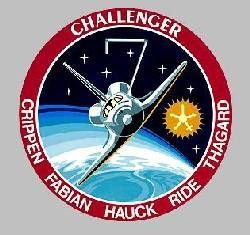 | STS-7 Credit: www.spacefacts.de |
 | STS-7 STS-7 launch Credit: NASA |
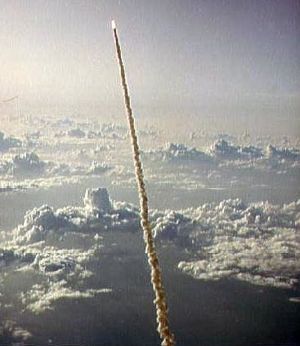 | STS-7 Air to air tracking views of the Challenger during launch of STS-7 mission Credit: NASA |
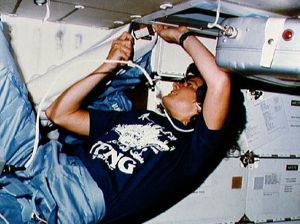 | STS-7 In-flight views of the crew of STS-7 Credit: NASA |
 | STS-7 Challenger's RMS arm grasps SPAS-01 during proximity operations Credit: NASA |
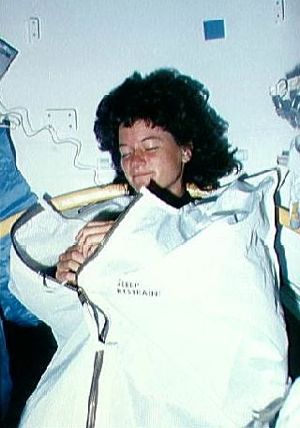 | STS-7 Mission Specialist (MS) Ride sleeps in airlock Credit: NASA |
 | STS-7 Commander Crippen and Pilot Hauck on middeck Credit: NASA |
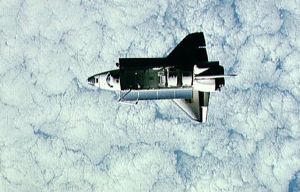 | STS-7 Full view of Challenger in space taken by the SPAS satellite Credit: NASA |
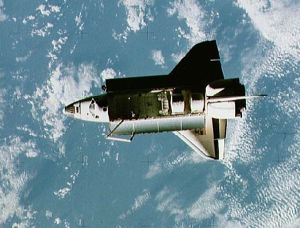 | STS-7 Full views of Challenger in space taken by the SPAS satellite Credit: NASA |
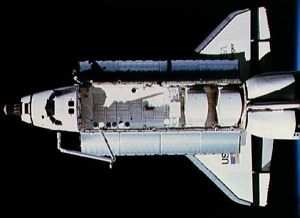 | STS-7 Full views of Challenger in space taken by the SPAS satellite Credit: NASA |
 | STS-7 Earth observations - STS-7 Credit: NASA |
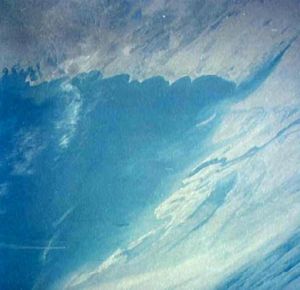 | STS-7 Northwest Persian Gulf Region Credit: NASA |
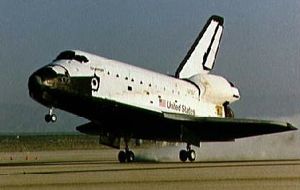 | STS-7 STS-7 Challenger landing at Edwards Air Force Base in southern California Credit: NASA |
1983 June 18 - . 11:33 GMT - . Launch Site: Cape Canaveral. Launch Complex: Cape Canaveral LC39A. Launch Platform: MLP1. LV Family: Shuttle. Launch Vehicle: Space Shuttle.
- STS-7 - .
Call Sign: Challenger. Crew: Crippen,
Fabian,
Hauck,
Ride,
Thagard.
Payload: Challenger F02 / OSTA-2. Mass: 16,839 kg (37,123 lb). Nation: USA.
Related Persons: Crippen,
Fabian,
Hauck,
Ride,
Thagard.
Agency: NASA Houston.
Program: STS.
Class: Manned.
Type: Manned spaceplane. Flight: STS-7.
Spacecraft Bus: Shuttle.
Spacecraft: Challenger.
Duration: 6.10 days. Decay Date: 1983-06-24 . USAF Sat Cat: 14132 . COSPAR: 1983-059A. Apogee: 307 km (190 mi). Perigee: 299 km (185 mi). Inclination: 28.30 deg. Period: 90.60 min.
Manned five crew. Deployed Anik C2, Palapa B1; deployed and retrieved SPAS platform. Payloads: Office of Space and Terrestrial Applications (OSTA)-2 experiments, deployment of PALAPA-B1 communications satellite for Indonesia with Payload Assist Module (PAM)-D and Telesat-F communications satellite for Canada with PAM-D, German Shuttle Pallet Satellite (SPAS)-01, seven getaway specials (GAS), Monodisperse Latex Reactor (MLR), Continuous Flow Electrophoresis System (CFES).
1983 June 19 - .
- STS-7 - Wakeup Song: University of Texas Fight Song - .
Flight: STS-7.
"University of Texas Fight Song" , of course, a tribute to the Mission Commander, Bob Crippen who is a UT graduate. It was preceded by the Texas A&M, Texas"Aggie", Fight Song which was a greeting card to Crip from Jerry Griffin, the Center Director at JSC, who is a Texas A&M graduate.
1983 June 20 - .
- STS-7 - Wakeup Song: A&M, Texas A&M Aggie War Hymn - . Flight: STS-7. "A&M, Texas A&M Aggie War Hymn" followed by"Tufts Tonia's Day" as rendered by the Tufts University Beelzebubs, which is a student acappella group at Tufts University, Rick Hauck's alma mater..
1983 June 21 - .
- STS-7 - Wakeup Song: Texas Aggie War Hymn - . Flight: STS-7. "Texas Aggie War Hymn" followed by"Reveille" followed by"When You're Smiling", as rendered by Mary Cleave's father, Mary Cleave, the CAPCOM for this crew, and in response, Challenger down linked some music of its own, some version of"Tequila Sunrise".
1983 June 22 - .
- STS-7 - Wakeup Song: Texas A&M Aggie War Hymn - . Flight: STS-7. "Texas A&M Aggie War Hymn" and the"Washington State University Cougar Fight Song", from which John Fabian is a graduate..
1983 June 23 - .
- STS-7 - Wakeup Song: Texas A&M, Texas Aggie War Hymn - .
Flight: STS-7.
"Texas A&M, Texas Aggie War Hymn" followed by the incomparable Leeland Stanford Junior University Marching Band, playing the"Stanford Hymn" which of course is the alma mater of Dr. Sally Ride and it sounded like the crew down linked a Beatles' song,"A Hard Day's Night".
1983 June 24 - .
- STS-7 - Wakeup Song: Texas Aggie War Hymn - . Flight: STS-7. "Texas Aggie War Hymn" that was followed by the"Florida State University Fight Song" played by the Florida State University Marching Chiefs. Norm Thagard is an alumnus of FSU..
1983 June 24 - .
- Landing of STS-7 - . Return Crew: Crippen, Fabian, Hauck, Ride, Thagard. Nation: USA. Related Persons: Crippen, Fabian, Hauck, Ride, Thagard. Program: STS. Flight: STS-7. STS-7 landed at 13:56 GMT. .
Back to top of page
Home - Search - Browse - Alphabetic Index: 0- 1- 2- 3- 4- 5- 6- 7- 8- 9
A- B- C- D- E- F- G- H- I- J- K- L- M- N- O- P- Q- R- S- T- U- V- W- X- Y- Z
© 1997-2019 Mark Wade - Contact
© / Conditions for Use